After a rocky year in Northeast Asia, prepare for another

2024 proved to be an unexpectedly dynamic year for Northeast Asia, and we must be ready for an equally unsteady 2025. Changes in political leadership, evolving ententes and uncertain policy trajectories may all contribute to confrontation, or they could open policy windows to de-escalation and cooperation. Both risk and opportunity await in the new year, and it will be up to policymakers to recognise them and take deliberate steps towards desired outcomes.
To prepare for the new year, it is essential to set the scene for the current political-military situation among the major Northeast Asian players: Russia, China, North Korea, South Korea and Japan. This builds a foundation for tackling the regional issues that await.
Immediate attention will fall to Russia, whose war of aggression against Ukraine has gained from participation by North Korean soldiers. Although both Pyongyang and the Kremlin disavow formal North Korean involvement, its personnel and materiel support reflects deepening ties, that were formalised in what they called the ‘Treaty of Comprehensive Strategic Partnership’ signed during Vladimir Putin’s visit to the North Korean capital in June. An outstanding question heading into the new year is what North Korean soldiers will be bringing back from the Ukrainian front lines, be it tactics, techniques, and procedures; Russian equipment and technology; or all of the above.
Another lingering question is how deepening Russo-North Korean ties will affect each country’s relationship with China. North Korea has demonstrated its capacity for deftly playing the Kremlin and Beijing off one another, and while China still maintains substantial economic leverage over the North Koreans, financial and resource support from Russia shifts the power dynamics.
China has also expanded outreach and contact with other governments since the last meeting of the National People’s Congress in March, including resumption of the Military Maritime Consultation Agreement mechanism meetings with the United States, a trilateral summit with South Korea and Japan in Busan, and a stated ‘turnaround’ in relations with Australia in 2024. While Russia seems unfazed by this outreach, its impact on Sino-North Korean relations bears observation.
Meanwhile, North Korea began the year with its most important policy declaration since its announcement in 1993 that it was withdrawing from the nuclear non-proliferation treaty. The government said in January that it was abandoning its decades-old unification policy with South Korea and, for the first time in its history, would recognise two sovereign states on the Korean peninsula. Steps to implement this policy soon followed, including dismantlement of inter-Korean related organisations and infrastructure. It also made substantial efforts to harden the boundary between the two Koreas with fences, walls and landmines.
Tensions on the Korean Peninsula were low throughout 2024. While Pyongyang employed tactics such as propaganda broadcasting and delivering trash into South Korea with balloons, it took measures to mitigate risk of runaway escalation. This was evident in early October when North Korea notified the US-led United Nations Command before dismantling roads and railways in the northern half of the demilitarised zone, as well as by its muted response to South Korea’s unexpected political turmoil in December. The forthcoming end-of-year Workers’ Party of Korea meeting will offer insight into its policy priorities for 2025, including possible signals to foreign governments—particularly the incoming US administration. Given its policy trajectory since abandoning unification with the South, North Korea may seek to normalise its status as a separate sovereign state in the coming year.
Elsewhere on the Korean peninsula, South Korea will enter 2025 in political disarray. Yoon Suk Yeol’s short-lived declaration of martial law led to his swift impeachment. While this demonstrated the strength of South Korea’s democratic institutions, the saga is not yet over. There is still a constitutional process to determine Yoon’s fate, which could take up to six months, including for deliberations in the country’s constitutional court. If it confirms Yoon’s removal, final resolution of the crisis with a general election may take a further two months.
While the exact date is unknown, observers should expect a new presidential administration in South Korea in 2025. Assuming the transition happens, a shift in power from the country’s conservatives to its progressives will be all but certain. As it stands, the current conservative platform, which champions South Korea’s role as a ‘global pivotal state’ and embraces multilateral security ties, will likely give way to a platform that returns the government’s focus to rekindling engagement with North Korea. While those two lines of effort are not mutually exclusive, past progressive administrations in South Korea have treated them as such, leading many observers to wonder what may come of the country’s outreach to NATO, its increased joint training with foreign partners such as Australia, and its improving relations with Japan.
In Japan, meanwhile, the Liberal Democratic Party will enter the new year as a minority government for the first time in decades. Prime Minister Ishiba Shigeru won his spot atop the government by a narrow margin in a surprise victory over intraparty opponents, further complicating the political landscape. Ishiba’s administration must navigate fraught political waters when attempting to pass legislation in the parliament, and the prime minister must do the same to build consensus within his own party.
Political discord and uncertainty tend to reinforce Japan’s foreign and security policy trajectory. In other words, formulation and implementation of those policies falls back to the historically strong bureaucracy that continues to move forward under the standing legislation and guidance. While this offers some stability, it presents challenges for championing new initiatives or adjusting to rapidly evolving situations. This may make it difficult for the Japanese government to respond to the changes that come with new US and South Korean presidential administrations or to any sudden shifts in Russian, Chinese or North Korean behaviour.
These conditions demand an agile approach to security decision-making in 2025. A new trilateral alliance forming between Russia, China and North Korea is not a foregone conclusion. Once-in-a-generation political conditions in South Korea and Japan should be given particular consideration by states looking to engage and respond to security issues. Those hoping for success must be ready to anticipate, assess and adjust to tackle the challenges that await in the new year.









 Getting caught up in geopolitical competition may seem uncomfortable enough for Pacific island countries. What’s making things worse is that outside powers’ struggle to influence them is weakening their resistance to organised crime emanating from China.
Getting caught up in geopolitical competition may seem uncomfortable enough for Pacific island countries. What’s making things worse is that outside powers’ struggle to influence them is weakening their resistance to organised crime emanating from China.